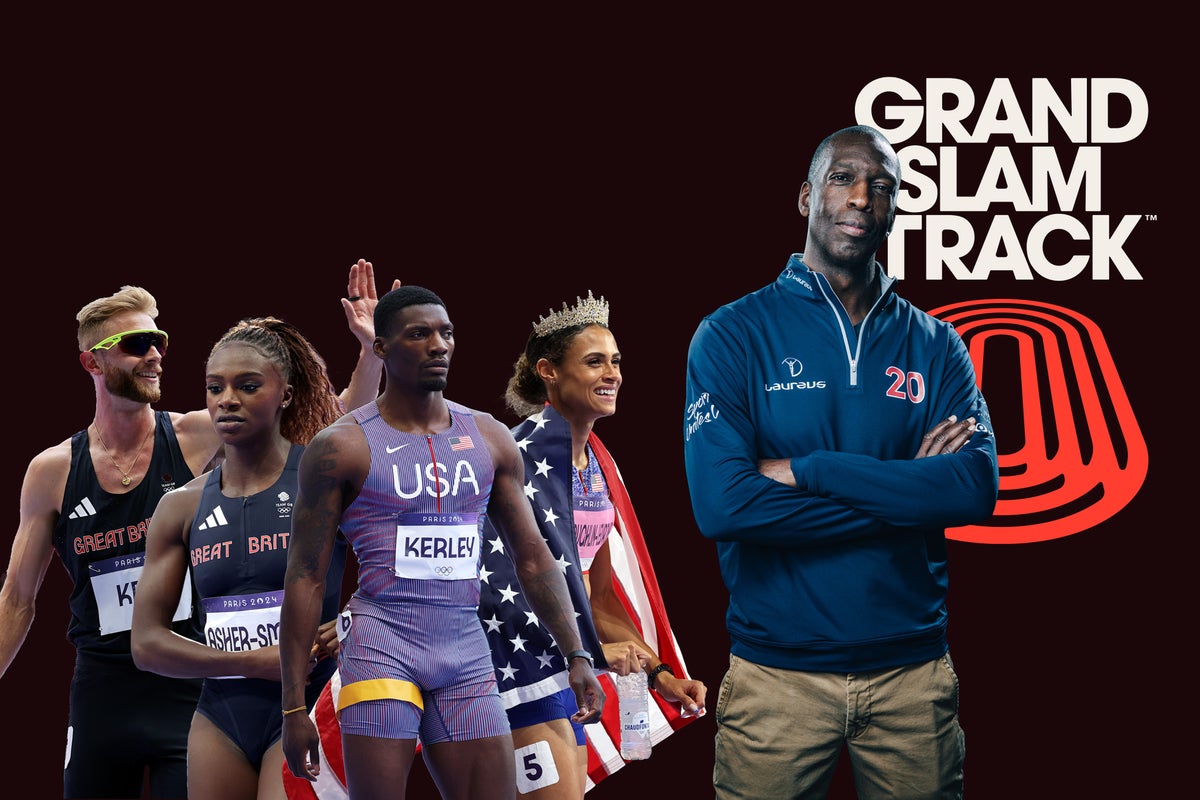
Michael Johnson and Steve Gera were having lunch at Soho House in Malibu two years ago, looking out over the Pacific Ocean, when they first sketched out a plan for what would become Grand Slam Track.
“He pitched me this idea,” recalls Gera, a former US Marine who became a coach and sports executive for several NFL teams and FC Barcelona. “I had the ‘aha’ moment of, oh my God, there is actually nothing in between the Olympics that is the best-of-the-best racers on a consistent basis. Yet this sport is so tremendously popular during the Olympics. Like, what happens?”
Grand Slam Track begins this week in Kingston, Jamaica, with a bold and brash promise to reinvigorate athletics, or at least part of it. An elite field of runners has signed up for the new track-only league – there are no field events – which will play out across four weekend-long meets in Kingston, Miami, Philadelphia and Los Angeles through April, May and June.
Johnson is the face of the project, a legend of the sport who delivered iconic moments gliding around the Atlanta track in 1996 wearing those famous gold shoes. Oddly, his profile is now far greater in Britain where he has worked as a popular pundit for the BBC, and this is something of a comeback into the American consciousness.
His co-founder, Gera is equally serious about the sport, and he is bullish about their ambitions. “We are maniacally focused on having the youngest fanbase of any sports league in the world in the next five years,” Gera tells The Independent. “That’s our North Star.”
They have laid the groundwork for success, raising more than £25m in funding and promising a £10m prize pot with around £77,000 for winning athletes. They have established dates and venues in a crowded calendar, and lured a litany of Olympic medallists, including American track stars Gabby Thomas and Kenny Bednarek, who will race against British record holders Dina Asher-Smith and Zharnel Hughes.
TV rights have been sold to major broadcasters covering more than 100 territories, with TNT Sports hosting the show in the UK. Grand Slam Track also has a betting link-up with Chicago-based sports tech company Stats Perform.
But the hard part is converting a compelling idea into lasting success, one that builds its own story and prestige, that develops value and meaning with jeopardy worth tuning in for. Making sport profitable, especially new endeavours like this one, is a difficult business.
The Saudi-backed LIV Golf had star players and vast investment to go with TV deals and an eye-watering marketing budget, but interest has somewhat petered out as it battles with the PGA Tour and DP World Tour for space and for stars. Why will Grand Slam Track be any different?
While it has some big names signed up, there are several missing too. One notable absentee is the men’s Olympic 100m champion Noah Lyles, who questioned the model on a recent podcast episode. “We’re two months out, and I’m looking – who are your outside sponsors, who are your non-track and field sponsors? I want to hear, is there a watch deal?”
But Gera is confident, pointing to a positive working relationship with the governing body, World Athletics, whose president Lord Sebastien Coe stated his public support for innovation in the sport. There is no golf-style civil war here, it seems. World Athletics has given Grand Slam Track official status and lists it as a sanctioned event in its calendar.
And the event has what Gera insists is a format that will engage young fans. They commissioned detailed research into not only what athletics fans wanted to see more of, but what fans of other sports such as golf and tennis would need to see in order to be enticed to sit down and watch athletics outside of the Olympics.
The answer was more stars, more often, racing head to head, which is why the format sees athletes pooled into groups of eight running two distances: those signed up to “short sprints” will run both 100m and 200m, forcing them to battle more than once over a weekend.
The TV viewing experience will be endowed with live performance data, which Gera hopes will bring the action to life in new ways.
The exclusion of field events has brought criticism but Johnson has been forthright in his response. “I am going to save what I think I can save,” he said. “I think I can save track, I don’t think I can save track and field.”
There were discussions about holding the series in a British city, with London and Birmingham in the frame, but UK Athletics had concerns over the potential cost of staging the event without guaranteed returns, while Gera says a first year in the Americas makes life simpler.
“The mayor’s office in London was great,” Gera says. “We had discussions with a couple of different cities across the UK [but] that was a decision that we made to just focus on tightly packaging our run of shows in year one. But we’re really excited to get the product into Europe in the not too distant future.”
That will depend on whether Johnson and Gera can turn Grand Slam Track into a success story. Athletics needs igniting, and Gera is convinced the concept will prove to be more than just another flicker in the sporting landscape.
Source: independent.co.uk


